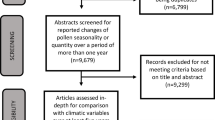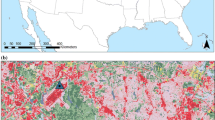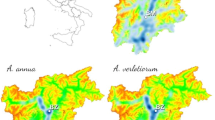Abstract
The buildup of greenhouse gases in the atmosphere has resulted in global climate change that is having a significant effect on many allergenic plants through increases in plant productivity and pollen allergenicity and shifts in plant phenology. Based on experimental studies, increased atmospheric levels of carbon dioxide have directly increased plant productivity. This has affected the total amount of pollen produced in some species. Research has also shown increased levels of birch allergen at warmer temperatures. Warmer temperatures have resulted in earlier flowering for many spring-flowering species in many countries, recorded through visual observations of flowering and by airborne pollen. Increases in the cumulative season totals of various pollen types also have been recorded; some of these increases may be explained by changes in plant distribution.
Similar content being viewed by others
References and Recommended Reading
Le Treut H, Somerville R, Cubasch U, et al.: Historical overview of climate change science. In Climate Change 2007: The Physical Basis. Contribution of Working Group 1 to the Fourth Assessment Report of the Intergovernmental Panel on Climate Change. Edited by Solomon S, Qin D, Manning M, et al. Cambridge: Cambridge University Press; 2007:93–127.
Beggs PJ, Bambrick HJ: Is the global rise of asthma an early impact of anthropogenic climate change? Environ Health Perspect 2005, 113:915–919.
Beggs PJ: Impacts of climate change on aeroallergens: past and future. Clin Exp Allergy 2004, 34:1507–1513.
National Oceanic and Atmospheric Administration, Earth System Research Laboratory: Trends in atmospheric carbon dioxide—Mauna Loa. Available at http://www.esrl.noaa.gov/gmd/ccgg/trends/. Accessed March 2008.
Forster P, Ramaswamy VR, Artaxo P, et al.: Changes in atmospheric constituents and in radiative forcing. In Climate Change 2007: The Physical Basis. Contribution of Working Group 1 to the Fourth Assessment Report of the Intergovernmental Panel on Climate Change. Edited by Solomon S, Qin D, Manning M, et al. Cambridge: Cambridge University Press; 2007:129–234.
Prentice CI, Farquhar GD, Fasham MJ, et al.: The carbon cycle and atmospheric carbon dioxide. In Climate Change 2001: The Scientific Basis. Contribution of Working Group 1 to the Third Assessment Report of the Intergovernmental Panel on Climate Change. Edited by Houghton JT. Cambridge: Cambridge University Press; 2001:184–238.
Trenberth KE, Jones PD, Ambenje P, et al.: Observations: Surface and Atmospheric Climate Change The Physical Basis. Contribution of Working Group 1 to the Fourth Assessment Report of the Intergovernmental Panel on Climate Change. Edited by Solomon S, Qin D, Manning M, et al. Cambridge: Cambridge University Press; 2007:235–336.
Vose RS, Easterling DR, Gleason B: Maximum and minimum temperature trends for the globe: an update through 2004. Geophys Res Lett 2005, 32:L23822.
Dai A, Karl TR, Sun B, Trenberth KE: Recent trends in cloudiness over the United States: a tale of monitoring inadequacies. Bull Am Meteorol Soc 2006, 87:597–606.
Long SP, Ainsworth EA, Rogers A, Ort DR: Rising atmospheric carbon dioxide plants FACE the future. Annu Rev Plant Biol 2004, 55:591–628.
Curtis PS, Wang X: A meta-analysis of elevated CO2 effects on woody plant mass, form and physiology. Oecologia 1998, 113:299–313.
Jablonski LM, Wang X, Curtis PS: Plant reproduction under elevated CO2 conditions: a meta-analysis of reports on 79 crop and wild species. New Phytol 2002, 156:9–26.
Norby RJ, Wullschleger SD, Gunderson CA, et al.: Tree responses to rising CO2 in field experiments: implications for the future forest. Plant Cell Environ 1999, 22:683–714.
Kimball BA: Carbon dioxide and agricultural yield: an assemblage and analysis of 430 prior observations. Agron J 1983, 75:779–788.
Rogers CA, Wayne PM, Macklin EA, et al.: Interaction of the onset of spring and elevated atmospheric CO2 on ragweed (Ambrosia artemisiifolia L.) pollen production. Environ Health Perspect 2006, 114:865–869.
Ziska LH, Caulfield FA: Rising CO2 and pollen production of common ragweed (Ambrosia artemisiifolia), a known allergy-inducing species: implications for public health. Aust J Plant Physiol 2000, 27:893–898.
Ziska LH, George K, Frenz DA: Establishment and persistence of common ragweed (Ambrosia artemisiifolia L.) in disturbed soil as a function of an urban-rural macroenvironment. Glob Chang Biol 2007, 13:266–274.
Wayne P, Foster S, Connolly J, et al.: Production of allergenic pollen by ragweed (Ambrosia artemisiifolia L.) is increased in CO2-enriched atmospheres. Ann Allergy Asthma Immunol 2002, 88:279–282.
Prasad PV, Boote KJ, Allen LH Jr, Thomas JM: Effects of elevated temperature and carbon dioxide on seed-set and yield of kidney bean (Phaseolus vulgaris L.). Glob Chang Biol 2002, 8:710–721.
Koti S, Reddy KR, Reddy VR, et al.: Interactive effects of carbon dioxide, temperature, and ultraviolet-B radiation on soybean (Glycine max L.) flower and pollen morphology, pollen production, gemination, and tube lengths. J Exp Bot 2005, 56:725–736.
Hendrey GR, Ellsworth DS, Lewin KF, Nagy J: A free-air enrichment system for exposing tall forest vegetation to elevated atmospheric CO2. Glob Chang Biol 1999, 5:293–309.
Ladeau SL, Clark JS: Elevated CO2 and tree fecundity: the role of tree size, interannual variability, and population heterogeneity. Glob Chang Biol 2006, 12:822–833.
Ladeau SL, Clark JS: Pollen production by Pinus taeda growing in elevated atmospheric CO2. Funct Ecol 2006, 20:541–547.
Ahlholm JU, Helander ML, Savolainen J: Genetic and environmental factors affecting the allerginicity of birch (Betula pubescens spp. czerepanovii [Orl.] Hämet-ahti) pollen. Clin Exp Allergy 1998, 28:1384–1388.
Hjelmroos M, Schumacher MJ, Van Hage-Hamsten M: Heterogeneity of pollen proteins within individual Betula pendula trees. Int Arch Allergy Immunol 1995, 108:368–376.
Mohan JE, Ziska LH, Schlesinger WH, et al.: Biomass and toxicity responses of poison ivy (Toxicodendron radicans) to elevated atmospheric CO2. Proc Natl Acad Sci U S A 2006, 103:9086–9089.
Wan S, Yuan T, Bowdish S, et al.: Response of an allergenic species, Ambrosia psilostachya (Asteraceae), to experimental warming and clipping: implications for public health. Am J Bot 2002, 89:1843–1846.
Sherry RA, Zhou X, Gu S, et al.: Divergence of reproductive phenology under climate warming. Proc Natl Acad Sci U S A 2007, 104:198–202.
Sparks TH, Carey PD: The responses of species to climate over two centuries: an analysis of the Marsham phenological record, 1736–1947. J Ecol 1995, 83:321–329.
Menzel A: Trends in phenological phases in Europe between 1951 and 1996. Int J Biometeorol 2000, 44:76–81.
Jackson MT: Effects of microclimate on spring flowering phenology. Ecology 1966, 47:407–415.
Beaubien EG, Freeland HJ: Spring phenology trends in Alberta, Canada. Int J Biometeorol 2000, 44:53–59.
Fitter AH, Fitter RS: Rapid changes in flowering time in British plants. Science 2002, 296:1689–1691.
Menzel A, Sparks TH, Estrella N, et al.: European phenological response to climate change matches the warming pattern. Glob Chang Biol 2006, 12:1969–1976.
Linderholm HW: Growing season changes in the last century. Agric For Meteorol 2006, 137:1–14.
Wolfe DW, Schwartz MD, Lakso AN, et al.: Climate change and shifts in spring phenology of three horticultural woody perennials in northeastern USA. Int J Biometeorol 2005, 49:303–309.
Cayan DR, Kammerdiener SA, Dettinger MD, et al.: Changes in the onset of spring in the western United States. Bull Am Meteorol Soc 2001, 82:399–415.
Schwartz MD, Reiter BE: Changes in North American spring. Int J Climatol 2000, 20:929–932.
Primack D, Imbres C, Primack RB, et al.: Herbarium specimens demonstrate earlier flowering times in response to warming in Boston. Am J Bot 2004, 91:1260–1264.
Miller-Rushing AJ, Primack RB: Global warming and flowering times in Thoreau’s concord: a community perspective. Ecology 2008, 89:332–341.
Rasmussen A: The effects of climate change on the birch pollen season in Denmark. Aerobiologia 2002, 18:253–265.
Emberlin J, Detandt M, Gehrig R, et al.: Responses in the start of Betula (birch) pollen seasons to recent changes in spring temperatures across Europe. Int J Biometeorol 2002, 46:159–170.
Van Vliet AJ, Overeem A, De Groot RS, et al.: The influence of temperature and climate change on the timing of pollen release in the Netherlands. Int J Climatol 2002, 22:1757–1767.
Spieksma FT, Corden JM, Detandt M, et al.: Quantitative trends in annual totals of five common airborne pollen types (Betula, Quercus, Poaceae, Urtica, and Artemisia), at five pollen-monitoring stations in western Europe. Aerobiologia 2003, 19:171–184.
Tedeschini E, Rodriguez-Rajo FJ, Caramiello R, et al.: The influence of climate change in Platanus spp. pollinating in Spain and Italy. Grana 2006, 45:222–229.
Levetin E: Effects of climate change on airborne pollen. J Allergy Clin Immunol 2001, 107:S172.
Lo E, Levetin E: Influence of meteorological conditions on early spring pollen in the Tulsa atmosphere from 1987–2006. J Allergy Clin Immunol 2007, 119:S101.
Drake B, Todd P: A Strategy for Control and Utilization of Invasive Juniper Species in Oklahoma: Final Report of the “Redcedar Task Force.” Oklahoma City, OK: Oklahoma Department of Agriculture, Food, and Forestry; 2002.
Van Auken OW, Jackson JT, Jurena PN: Survival and growth of Juniperus seedlings in Juniperus woodlands. Plant Ecol 2004, 175:245–257.
Knapp PA, Soulé PT: Recent Juniperus occidentalis (western juniper) expansion on a protected site in central Oregon. Glob Chang Biol 1998, 4:347–357.
Levetin E, Avery J: Long term trends in airborne ragweed pollen in Tulsa, Oklahoma: 1987 to 2006. J Allergy Clin Immunol 2008, 121:S21.
Author information
Authors and Affiliations
Corresponding author
Rights and permissions
About this article
Cite this article
Levetin, E., Van de Water, P. Changing pollen types/concentrations/distribution in the United States: Fact or fiction?. Curr Allergy Asthma Rep 8, 418–424 (2008). https://doi.org/10.1007/s11882-008-0081-z
Published:
Issue Date:
DOI: https://doi.org/10.1007/s11882-008-0081-z




